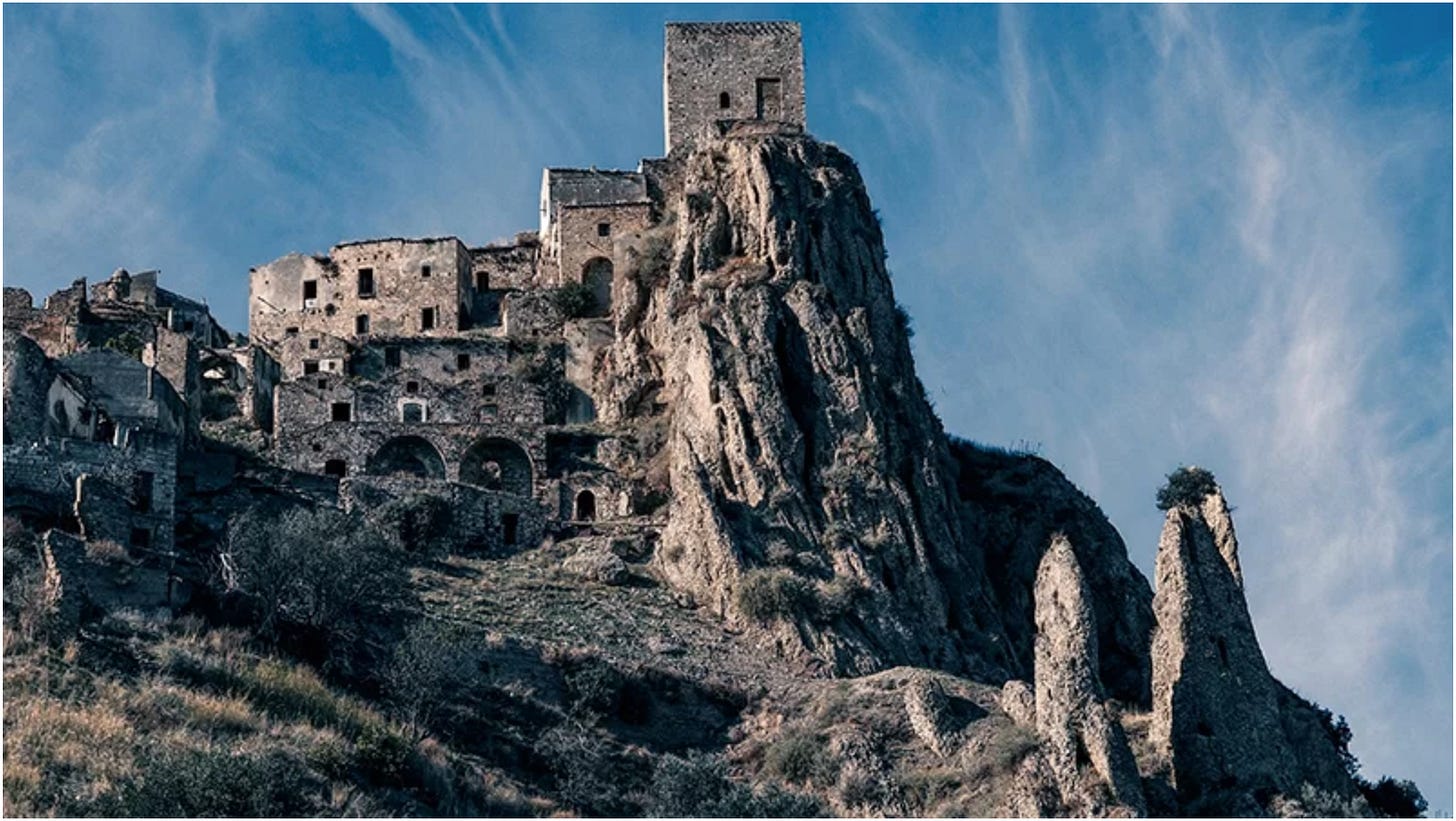Cities and Culture: Part 3 of 3
In the world are places that exist but are not alive— 'ghost towns' remain as relics of history, each waiting for its mysterious tale to unfold.
A mini-series for supporters. If you’re interested in the topic of culture and cities, consider becoming a supporter. This 3-part mini-series will run in the next couple of weeks.
Part 1 was an overall review of the innovations that cities brought to the 12th and 13th century, creating the context that led to the Renaissance.
Part 2 was a travel through time in a place that exists outside time, an ‘ideal city’ built to measure a man with his own mortality.
In part 3 we take a tour of a few ‘ghost towns,’ places where once humanity thrived and now sit empty and are slowly corroding away, but only if we let them go forgotten.
In this third and final installment of this miniseries, I wanted to talk about ghost towns.1 As I looked into various options—Pompeii being top of mind for Italy—I noticed that the faith of cities without people fell into broad categories.
Humanity’s broader narrative includes places where immense tragedies have occurred—floods, prolonged droughts, government actions, uncontrolled lawlessness, unemployment, war, pollution or nuclear disasters. Cities that gave up the ghost.
In other cases, however, these towns have a second life and are starting to be revalued by international tourism, while remaining mysterious and, at times, disturbing phenomena.
Why did people abandon settlements? What made them decide to leave their homes and lives to move elsewhere?
These cities have the charm of the history in which they are immersed, of silent, deserted buildings and sometimes submerged streets. What remains visible tells only part of the story. How recently these settlements were abandoned is part of it.
Through the traces of what they once were, ghost towns are silent witnesses to human affairs—hopes, dreams, plans. They exist in the past to remind us that they were once centers full of life.
Reminder: This is just a teaser. You can support my work and get extra insights—in-depth ideas, information, and interviews on the value of culture.
Become a supporter and access new series, topic break-downs in The Vault.
Ghost towns are not only images in films. Throughout the world, there are mysterious abandoned cities that stand like menacing time capsules that capture the imagination and vacation days of thousands of tourists.
From the incredible city of Kolmanskop, almost completely buried under the Namibian desert, to the Italian city of Craco, where ‘The Passion of the Christ’ was filmed. From the Ukrainian city of Pripyat, abandoned after the Chernobyl disaster, to the English city of Tyneham—in Italy and around the world, there are numerous uninhabited cities.
Since we’ve been visiting Italy so far, let’s take a few more stops in our itinerary before we zoom out into the wider world.
Frozen in time
Come with me all the way to the southern region of Basilicata—to Craco. The oft-forgotten small region is home to a pictures-famous ‘ghost town.’ Though 700 people live in Craco, the original center was evacuated in the 1960s.
A series of destructive landslides left the town’s historic center completely uninhabited. Things worsened in 1972 after a flood prevented any repopulation. The earthquake of 1980 was the coup de grâce.
After that, old Craco was abandoned definitively.
Since then, its perched houses and alleys have become mysterious and silent. But this was perhaps its greatest fortune. Craco’s inhabitants have preserved the beauty of the original center with great care. They’ve never forgotten their native land.
The city, which can be visited, has become a set for many film productions over the years. Scenes from ‘The Passion of the Christ,’ directed by Mel Gibson and 007 Bond franchise’s ‘Quantum of Solace’ were shot there.
As many Italian towns perched on mountains, Craco’s origins are ancient. It was a primitive settlement in the 8th century BC. The great urban development came in the Middle Ages under the influence of the Byzantines, then the Normans.
Byzantium brought agriculture in the area, and a monastic order settled here. The name Craco probably originates from Graculum, ‘small ploughed field.’
Under Norman rule, the center developed into a village. It became an important strategic center during Frederick II’s reign. The Craco Tower, which allows to dominate the Cavone and Agri rivers was built at that time.
The population kept growing, and reached 2,590 in the year 1561. Then the Black Death arrived in the mid-1600s, and took out hundreds of residents. In the centuries that followed, the town saw the construction of numerous noble palaces, such as Palazzo Maronna and Palazzo Grossi.
When the turbulence of the post-unification period (twentieth century) was over, Craco continued peacefully its life as a small rural center. Although affected until a few years before its ‘end’ by intense land ownership, the agricultural production of Craco was among the most flourishing in the entire region.
Before it became a ‘ghost town’, Craco was a ‘Wheat Town.’ By the 1960s, so much wheat was being produced that the approximately 2,000 inhabitants were unable to cope with the cultivation needs of the immense lands of the noble families of the place, having to request the contribution of laborers even from Salento (Puglia).
Symbol of resilience and belonging
Keep reading with a 7-day free trial
Subscribe to On Value in Culture to keep reading this post and get 7 days of free access to the full post archives.






